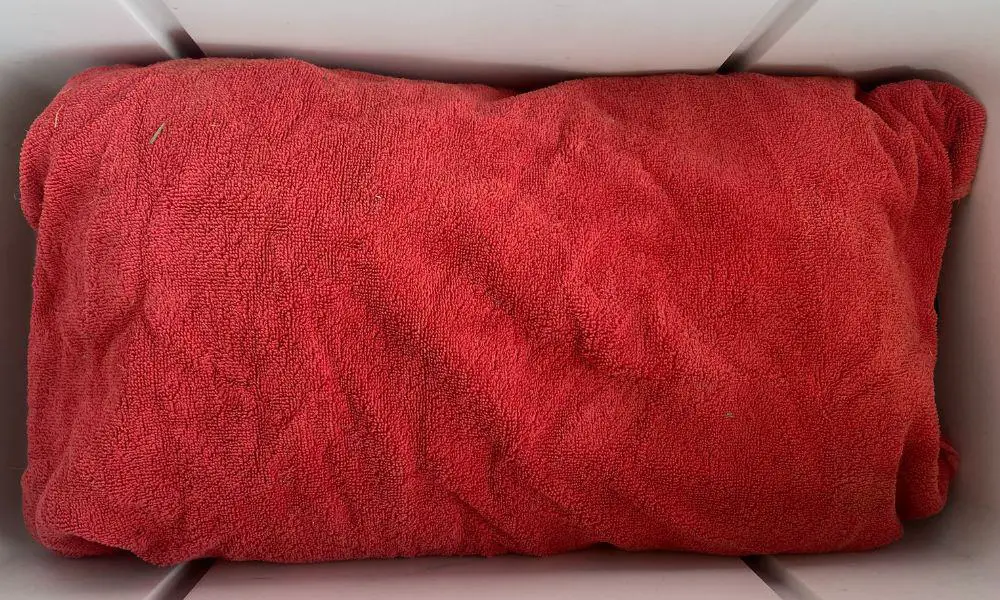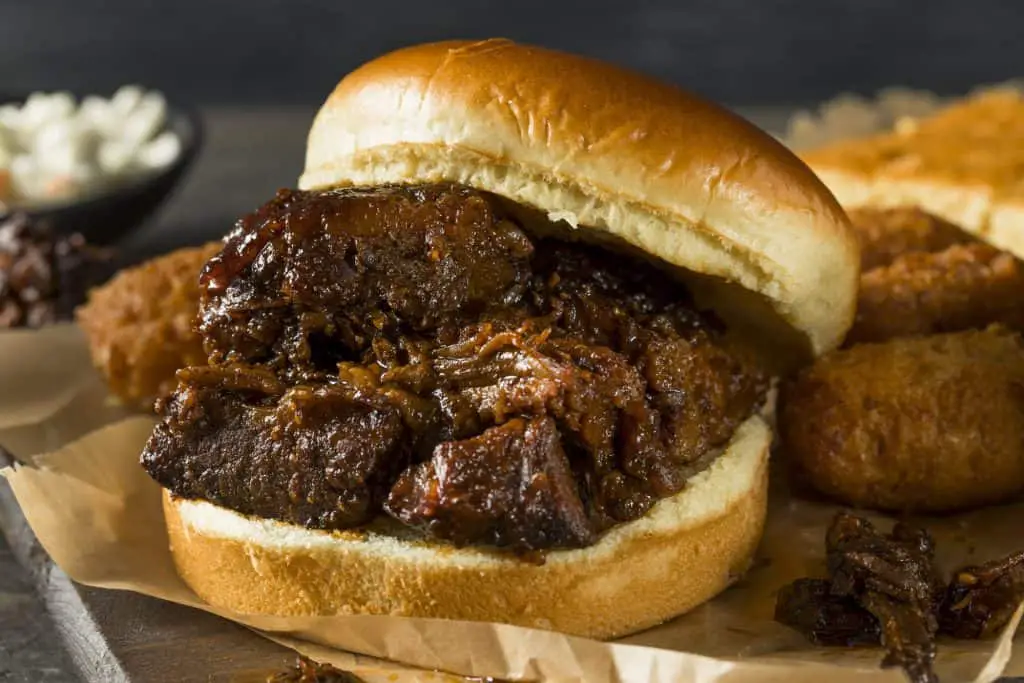A brisket done too early can almost be just as challenging as a brisket that’s taking too long. Especially when the brisket has turned out so well, but just earlier than expected!
Luckily, if your brisket is done too early you do have several ways to keep it warm safely for hours, without ruining or overcooking the brisket.
Don’t panic. Let’s look at the options you have that you can act on NOW, and what you can do in the future to prevent the brisket from cooking too quickly too.
How To Keep Brisket Warm When It’s Done Too Early

Although the rule of thumb is 90 minutes of low and slow cooking time per pound of brisket this is merely a guide. If someone hands you a 10-pound brisket, depending on your smoker (or other slow cooker), the temperature, and all the other conditions, it could be ready anywhere between 8-18 hours.
So, if your brisket is done too early, or nearing your desired doneness long before you’re ready to eat then you’re going to want to take action.
If your brisket is done too early you can wrap it tightly in foil, followed by wrapping it in a towel, and rest it in a cooler for up to 4-6 hours.
This is known as the cooler method (or Faux Cambro).
But, depending on your timeframes, or if you are cooking brisket for a crowd, you could use the oven method, rest and reheat method, or even make some delicious burnt ends.
Wrap and Rest: The Cooler Method

If you’ve been around barbecue long enough you will have heard of the cooler method or “Faux Cambro” when it comes to resting meats. Although this method is traditionally used to rest the beef brisket, it can also hold the temperatures extremely well which makes it an ideal option if your brisket is done too early.
Around thirty minutes before your brisket is ‘done’ add roughly three gallons of hot water to your cooler and close the lid.
As soon as your brisket is ready to take off the heat, drain and wipe down the cooler. The heat that the cooler has absorbed will remain hours after the hot water has been removed because of how good of an insulator it is.
Ideally get a probe into the brisket, re-wrap it up in butcher’s paper or aluminium foil and wrap it in a thick towel. Place the wrapped brisket in the cooler, run the probe wire out of the cooler and shut the lid.
The probe will help you monitor the temperature to ensure it doesn’t drop into unsafe levels under 140°F. If it does appear to be falling below 140°F take it out and put it into a refrigerator to be safe.
If done correctly, you will quite easily be able to hold the brisket’s temperature for up to 6 hours, and even longer in optimal conditions. Every step involved is to provide the brisket with well needed insulation, holding temperatures for as long as possible without overcooking or ruining the brisket.
You can adopt this method for resting turkey if it’s done too early, or resting pork ribs too!
Rest In The Oven On Low
It’s well known that in professional or commercial barbecue do not use a cooler to rest and hold their brisket at temperature. Can you imagine rocking up to Franklin Barbecue and seeing Aaron Franklin lifting your smoked brisket out of a cooler to serve?
Now, aside from the fact that it wouldn’t be realistic to do that process with many briskets, there’s a good reason they use a hot box. A commercial hotbox allows you to store meat at your desired temperature for as long as you wish, and in some barbecue restaurants, this can exceed 17 hours!
This same process can be replicated with your standard conventional oven.
Simply preheat your oven to as low as it gets, ideally 160-170°F, place the wrapped brisket in the center of the oven and play the waiting game. If your oven doesn’t go as low as 170°F you can still try this, but anything over 180°F will tend to continue cooking the brisket rather than just resting the brisket.
So, if your brisket is done too early, you can easily and safely rest it in your oven for up to 8 hours, ideally with a wireless temperature probe in the brisket to track its internal temperature trying to hold it around the 150-160°F mark.
Chris from VirtualWeberBullet did extensive tests on this, and the video explaining everything can be watched below:
Rest And Reheat Method
Depending on how early the brisket is, you may wish to play it safe and simply rest then reheat the meat when you’re ready to serve. This will ensure you don’t overcook the meat at all but still have adequate resting time for the juices to settle, reabsorb, and redistribute throughout the meat.
Simply rest for as long as you desire using what you’ve got. Whether that’s in a cooler in a towel, or just on the bench for a few hours. After the brisket has come down to around 145-150°F place the whole brisket in the fridge.
One hour before you’re ready to serve, simply take the brisket out of the fridge, preheat your oven while the brisket warms up a bit, then place the brisket in the oven and bring it to at least 160°F before slicing and serving.
Make Burnt Ends

If you have extra time on your hands and your brisket is done too early, then you can make the choice to turn the whole brisket, or just part of it into brisket burnt ends. You can use both the flat or the point to equal success, but I find the flat works nicely.
You can rest the brisket normally, then cut 1 inch cubes from the brisket, lather them in barbecue sauce, spices, and honey and continue cooking them for an extra hour or two to get them really crispy, tender, and almost too delicious to share.
This will add a few hours to your cook and ensure that the meat stays hot and safe to eat for your guests.
You’ll know the burnt ends are done when they’ve absorbed the sauce and taken on a pleasantly crisp texture. Take the burnt ends out of the smoker, then serve them as an entrée or side dish. You could also sandwich them between buns or slices of bread like you would sliced brisket. Your guests might be so impressed that you’ll serve burnt ends as the entrée instead of a last-minute solution next time you host a cook-up!
When Is Brisket Considered Done?
There are a few different opinions floating when it comes to brisket doneness.
Just to clear things up, although the general consensus is that brisket is done at 210°F, most professional pitmasters cook brisket to tenderness not internal temperature. This also accounts for scenarios when brisket cooks too quickly, showing a temperature of 210°F but not having nearly enough time for all the fat and connective tissue to break down properly.
This is one of the biggest mistakes beginners make when smoking brisket, and it often leads to a tough brisket.
For the best results, when your brisket starts reaching temperatures of about 190-195°F start testing for tenderness by inserting your probe into various places in the brisket. If you’re happy with the tenderness then you can pull it off, knowing that it will rise between 10-15°F degrees further as it rests before the temperature starts to drop.
If your brisket is at 195°F but still feels tough, then crank the heat down on your smoker to 225°F and keep the brisket going for up to 205°F before taking it off, to give it the most time possible to finish up.
Can You Leave A Cooked Brisket Out Overnight?
In the right conditions you CAN leave a cooked brisket out overnight, or up to between 6-8 hours. In order to do this safely you will have to keep an eye on the temperature of the brisket, making sure it holds above 140°F.
To leave a cooked brisket out overnight you will need to adopt the Faux Cambro technique, utilising your cooler, a towel, and your wrapped brisket.
Thirty minutes before your brisket is done fill a cooler about ¼ full of hot water and close the lid. Once you’re ready to take the brisket off, drain the cooler and dry it out with paper towels. Get a wireless probe in the brisket (or run the wire out), re-wrap it up, and wrap it in a decently thick towel. Place the wrapped brisket in the cooler and close the lid.
Tip: if you’re going to rest the brisket for more than a few hours, pour a cup of boiling water over the towel before you close the lid.
If the above steps have been executed well, and with a high quality cooler, you should be able to rest your brisket for up to 8 hours, so long as the internal temperature remains above 140°F for food safety.
How To Stop Brisket Cooking Too Quickly
To keep your brisket from cooking too quickly, use a meat thermometer to keep an eye on the temperature. Lower the temperature to between 200-225°F if the brisket is cooking more quickly than you’d hoped.
If you’ve identified that the brisket is cooking too fast and the brisket will be done too early, then take the opportunity to spritz your brisket more often. This will encourage more evaporative cooling, delaying the formation of the bark and keeping the temperature lower.
This strategy is great for adding more smoke flavor to the brisket too, as the increase in humidity and moisture on the brisket helps the smoke adhere and create an amazing looking smoke ring on your brisket.
What About The Stall?
The brisket stall, or “the stall” is the phenomenon where the moisture in the brisket begins cooling more quickly that the temperature in the smoker can push through. Although this isn’t indefinite, the brisket stall can last hours and hours.
Usually, to combat the stall, you will wrap the brisket in high-quality butcher’s paper (ideally) or aluminum foil. This prevents evaporative cooling from the surface of the brisket as all the moisture is locked in. Instead, the moisture turns to steam which more easily continues to cook the brisket.
Before you wrap you want to be sure that you are satisfied with the bark formation and also the deep mahogany color on the brisket. If your brisket is cooking too quickly, then you can easily just delay the wrapping process and push through the stall a bit further. This allows you to build more layers of smoke flavor, a heftier bark, and of course, will stop your brisket being done too early!
If your brisket didn’t stall, then continuing to cook it until it probes like butter is the best way to ensure it still comes out brilliantly tender and delicious.


3 thoughts on “Brisket Done Too Early – What You Can Do”
On the rest and reheat method at what temp do you preheat the oven for?
Hey Bobby!
160-180°F does the trick!
Thanks sir.